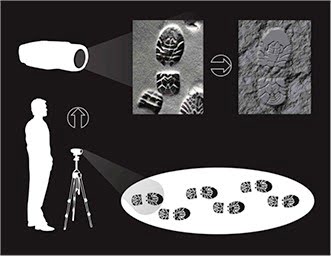Encoding data in LED light could lead to improvements in portable crime scene forensics technology, allowing investigators to take more precise high-resolution 3D images of shoeprints and tire-tread marks in snow and soil.
The "binary defocusing technique" is projected onto the snow or soil surface. The light bouncing back to the camera contains the pre-encoded information, allowing the system to determine the depth of surface features while using a single camera. A laptop computer will perform necessary computations needed to operate the projector and camera. Unlike some other systems, the new approach does not require the use of lasers.

This graphic depicts the operation of a new, portable crime-scene
forensics technology designed to take precise, high-resolution 3D images of
shoeprints and tire-tread marks. The technology works by encoding data in LED
light that is projected onto the snow or soil surface, allowing the system to
determine the depth of surface features while using a single camera. Courtesy
of Song Zhang/Purdue University.
"Current 3D imaging products on the market are very difficult to use," said Song Zhang, an associate professor at Purdue University School of Mechanical Engineering and director of Purdue's XYZT Lab. "You need expertise to be able to capture good images. What we want to do is bring in some intelligence to the algorithms so the forensic examiner just has to click a button to capture good images."
With help from a two-year, $788,167 grant from the National Institute of Justice, Zhang's team is working on the 3D imaging system that will have “auto-exposure control.” The system will also have an intuitive user interface, allowing investigators with little to no technical expertise to take high-quality images.
The research team comprises Zhang, forensic research scientist David Baldwin of the Special Technologies Laboratory — a U.S. Department of Energy National Nuclear Security Administration facility in Santa Barbara, Calif. — retired forensic scientist and footwear and tire track examiner James R. Wolfe, and two doctoral students.
The team hopes to develop a system that produces immediate images with a resolution of 600 dpi, providing more precise results than casting.
"Our project has promise to deliver a device that will improve the quality and accuracy of tire and footwear impression evidence," Baldwin said. "We plan to develop an affordable and easy-to-use system that will provide the forensic science community with more and better evidence from crime scenes."
According to the researchers, snow and light sand are difficult to photograph and make castings in. The team is now working on that issue.
"This project has the potential to develop a system that can quickly obtain the 3D detail in such impressions, maximizing the value of this type of evidence in a criminal investigation," Wolfe said.
The system will cost about one-tenth the cost of commercial systems, with a price tag of around $5000, and will serve as an alternative to traditional plaster casting methods. The project officially begins in January 2017.